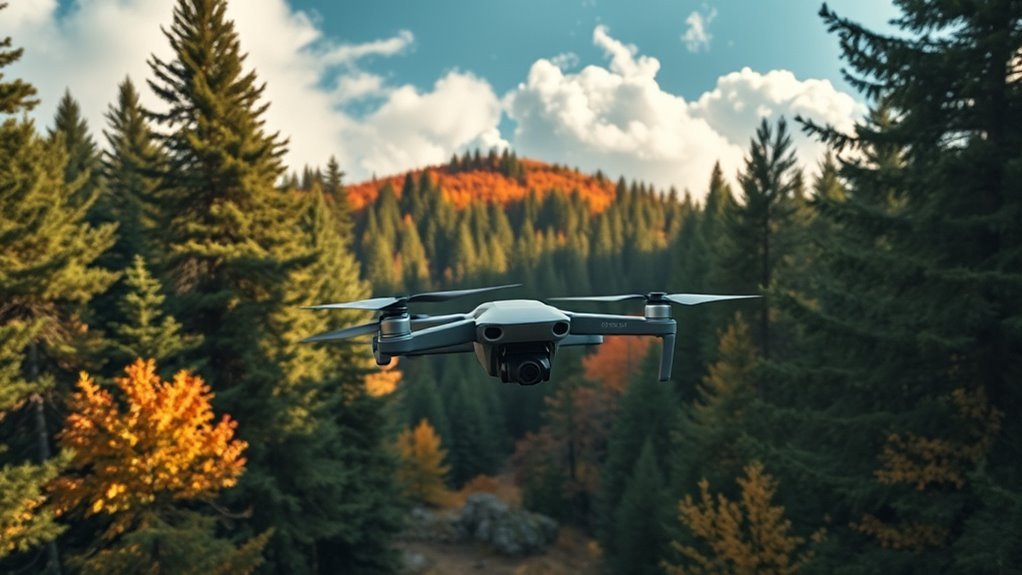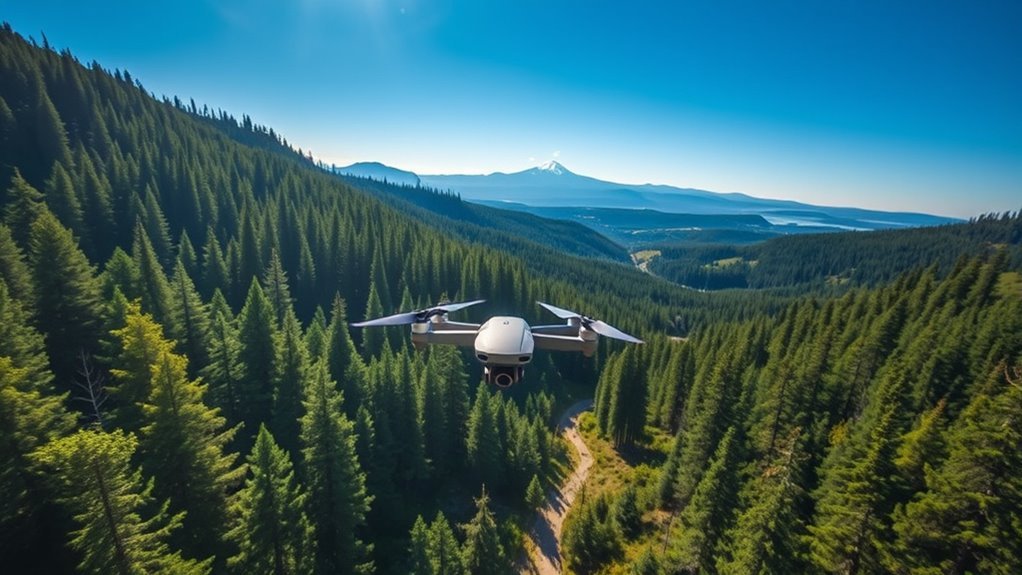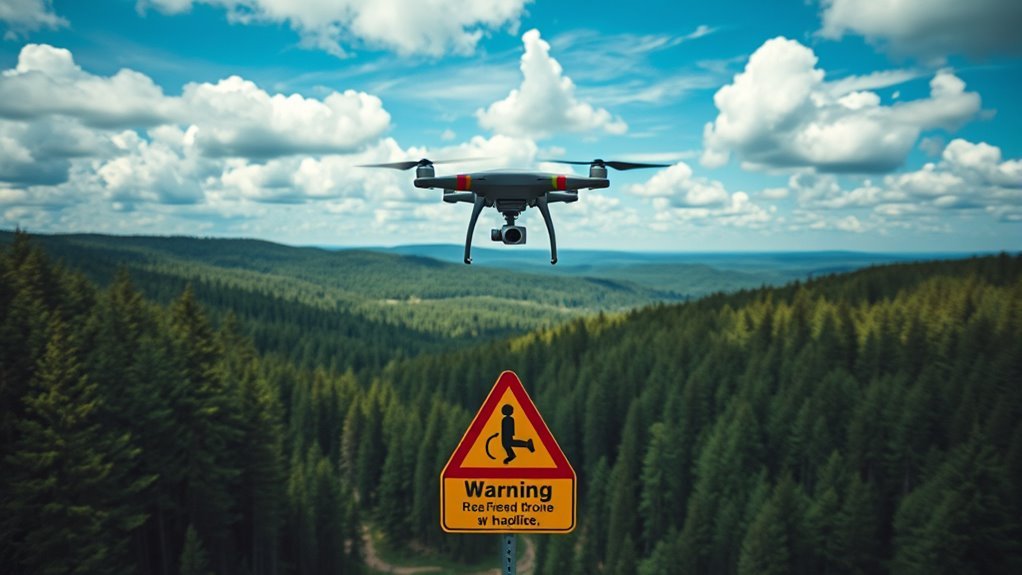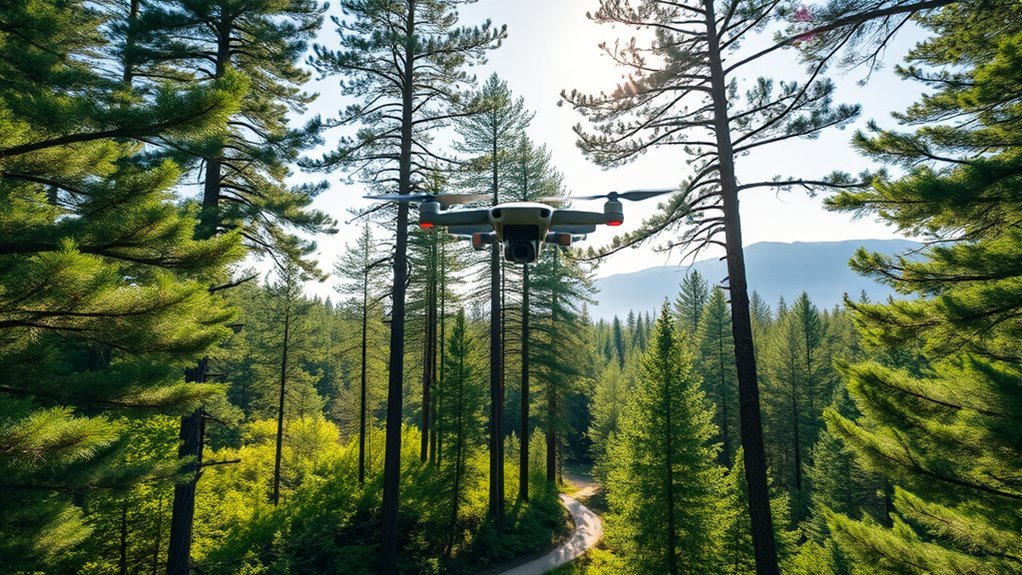When flying drones in national forests, you must follow U.S. Forest Service regulations by obtaining required permits and guaranteeing your drone is FAA-registered if over 0.55 pounds. You need to keep your drone within visual line-of-sight, avoid disturbing wildlife, and fly only in designated areas below 400 feet. It’s critical to comply with safety protocols and not interfere with firefighting or law enforcement activities. Understanding these rules guarantees responsible operation and protects natural resources—explore how to stay fully compliant.
Understanding National Forest Drone Regulations

Although flying drones offers unique opportunities for exploration, you must adhere to specific regulations set by the U.S. Forest Service when operating in national forests. Drone technology has advanced, enabling enthusiasts like you to capture stunning wildlife photography, but these freedoms come with restrictions designed to protect natural resources and wildlife habitats. You’re required to fly drones only in designated areas, maintain visual line-of-sight, and avoid disturbing wildlife or other visitors. Additionally, drones must not interfere with firefighting efforts or law enforcement operations. Understanding these regulations guarantees you can responsibly utilize drone technology to explore and document national forests without compromising preservation goals. Staying informed and compliant helps safeguard your freedom to operate while respecting the environment and public safety standards established for these protected lands.
Obtaining Necessary Permits and Permissions

Before you fly a drone in a national forest, you’ll need to secure the appropriate permits and permissions from the U.S. Forest Service. Compliance with federal regulations is mandatory, and failure to obtain authorization can result in penalties. First, confirm your drone registration is current with the FAA, as all drones over 0.55 pounds must be registered before operation. Next, contact the specific national forest office where you intend to fly to request a Special Use Permit or confirm if your activity falls under existing exemptions. These permits outline operational limits and safety requirements, balancing your freedom to fly with legal and environmental responsibilities. Always maintain documentation of your permits during flights, as enforcement agents may request verification at any time.
Respecting Wildlife and Natural Habitats

When operating a drone in national forests, you must prioritize minimizing disturbance to wildlife and their habitats. Avoid flying close to animals or nesting sites, as even minor wildlife disturbances can cause stress or disrupt natural behaviors. Maintain altitude and distance to prevent interference with sensitive species. Habitat preservation requires you to refrain from landing or taking off in fragile ecological zones or areas with rare vegetation. Stick to established trails and clearings when possible to reduce your environmental impact. Adhering to these measures guarantees your drone use respects the ecosystem’s integrity, allowing you to enjoy the freedom of flight responsibly. Remember, safeguarding wildlife and preserving natural habitats are not just regulations—they’re essential to sustainable drone operation within national forests.
Safety Guidelines for Drone Operation
Since operating a drone in national forests involves complex and dynamic environments, you must adhere to strict safety guidelines to prevent accidents and guarantee legal compliance. Prioritize drone safety by conducting thorough pre-flight inspections, ensuring your equipment functions flawlessly. Follow operational guidelines by maintaining visual line-of-sight with your drone at all times and flying below 400 feet to avoid conflicts with manned aircraft. Avoid flying near people, wildlife, or restricted zones to minimize risk and disturbance. Always check for temporary flight restrictions or closures issued by forest authorities. Use GPS and obstacle avoidance systems to navigate safely through dense terrain. By strictly following these protocols, you preserve both your freedom to fly and the integrity of national forests, ensuring responsible and secure drone operations in protected environments.
Consequences of Violating Drone Rules in National Forests
Although flying drones in national forests offers recreational and professional opportunities, violating established rules can lead to significant legal and financial consequences. You must understand that non-compliance with federal and forest-specific regulations often results in fines and penalties that may severely impact your budget. Additionally, authorities are empowered to enforce drone confiscation if you operate without proper authorization or in restricted zones. These enforcement actions are designed to protect wildlife, preserve natural resources, and maintain public safety. Ignoring these rules not only jeopardizes your freedom to fly but also risks escalating legal complications, including potential criminal charges. To maintain your operational freedom and avoid costly repercussions, you need to strictly adhere to all posted regulations and obtain necessary permits before flying in national forests.

